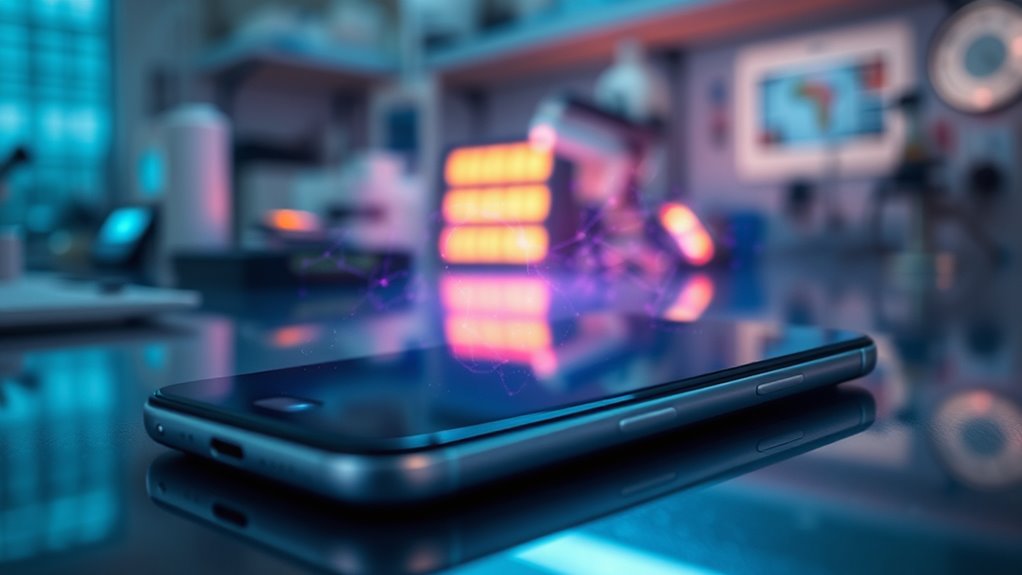Cell phones emit non-ionizing electromagnetic radiation, mainly causing heating effects rather than directly damaging DNA. This radiation interacts with brain tissue when you hold your phone close, but current studies suggest typical use isn’t linked to serious brain damage. Concerns focus on long-term exposure and subtle effects on neural activity. While regulations limit RF exposure, adopting habits like using headphones or speakerphone can help. If you keep exploring, you’ll discover more about how EM radiation impacts your brain health.
Key Takeaways
- Cell phones emit non-ionizing RF radiation that mainly causes tissue heating, not direct DNA damage.
- Current safety standards limit RF exposure, reducing but not eliminating potential subtle biological effects.
- Non-ionizing radiation interacts primarily through thermal effects, which may influence neural activity minimally.
- No conclusive evidence links typical cell phone radiation levels to brain damage, but long-term effects are still under study.
- Using hands-free devices and limiting call duration can help minimize potential risks from electromagnetic radiation.

Many experts warn that frequent cell phone use may pose risks to brain health, prompting questions about the potential for brain damage. As you use your phone daily, you might wonder how safe it truly is, especially concerning radiation exposure. Phone safety has become a major concern because cell phones emit radiofrequency (RF) radiation, a form of non-ionizing electromagnetic (EM) radiation.
Experts warn frequent cell phone use may impact brain health due to RF radiation exposure.
Unlike ionizing radiation from X-rays or radioactive materials, non-ionizing radiation is generally considered less harmful because it lacks enough energy to directly damage DNA. However, the long-term effects of constant exposure remain a subject of scientific investigation.
When you hold your phone close to your head during calls, your brain is exposed to this RF radiation. While regulatory agencies like the Federal Communications Commission (FCC) set safety limits on radiation exposure, some studies suggest that prolonged, heavy use could still have subtle biological effects.
The key concern revolves around whether this radiation can penetrate the skull and influence brain tissue. Although the energy levels are low, they’re enough to induce thermal effects—small increases in tissue temperature—and potentially impact neural activity over time. This is why many advocates stress the importance of phone safety measures, such as using speakerphone, headphones, or texting instead of lengthy calls, to minimize direct contact.
Understanding the chemistry of EM radiation helps clarify why this issue is complex. Non-ionizing radiation, including that from cell phones, doesn’t cause immediate cell damage like ionizing radiation does. Instead, it interacts with tissues primarily through heating. Recent studies on electromagnetic interactions have deepened our understanding of how EM fields may influence biological tissues at the cellular level, emphasizing the importance of ongoing research in this area.
This heating effect, if persistent and intense, might contribute to cellular stress or minor changes in brain activity. But current research hasn’t conclusively linked typical cell phone radiation levels to brain damage. Instead, scientists are exploring whether long-term, low-level exposure could subtly influence brain function or contribute to health issues over decades.
Additionally, advancements in projector technology have improved our understanding of how electromagnetic exposure might affect biological tissues, emphasizing the importance of ongoing research in this area.
You should also consider the role of regulatory standards in ensuring phone safety. These standards are designed to keep radiation exposure well below levels that could cause harm. Still, because technology evolves rapidly and long-term data is limited, many health authorities recommend precautionary measures.
Using hands-free devices and limiting call duration can reduce radiation exposure and improve your overall phone safety. Staying informed and adopting simple habits can help you mitigate potential risks while enjoying the convenience of modern communication.
Frequently Asked Questions
Are Children More Vulnerable to EM Radiation From Cell Phones?
You might wonder if children are more vulnerable to EM radiation from cell phones. Kids’ pediatric brain development makes them more sensitive, as their brains are still growing and developing.
Their radiation sensitivity is higher because their skulls are thinner, allowing more radiation to reach delicate tissues. Consequently, it’s wise to limit children’s exposure to EM radiation, protecting their ongoing brain development and reducing potential risks associated with cell phone use.
What Safety Standards Exist for Cell Phone Radiation Exposure?
You might think safety standards are strict, but ironically, FCC regulations set SAR limits that let phones emit radiation close to maximum safe levels. These limits are designed to protect you, but many argue they’re not enough.
As long as your device stays within these standards, it’s deemed safe—though some experts believe ongoing research suggests we should be more cautious. So, you’re technically within safety bounds, but should you be?
Can EM Radiation Cause Long-Term Neurological Health Issues?
You might wonder if EM radiation from cell phones can cause long-term neurological health issues. While biological effects are observed at high exposure levels, typical use remains below safety limits.
Chemical mechanisms, like heat or oxidative stress, could potentially impact brain cells over time. However, current evidence doesn’t conclusively link everyday exposure to lasting neurological damage.
Though ongoing research continues to evaluate these possible long-term health effects.
How Do Different Cell Phone Models Compare in Radiation Emission?
Imagine a race where each phone model is a runner with a different speed. Device design greatly influences emission levels—sleeker models often emit less radiation, like a runner conserving energy.
You should compare emission levels listed on manufacturer specs; newer designs tend to be safer.
Are There Protective Devices to Block Cell Phone EM Radiation?
You can find protective devices like Faraday cages and shielding materials to block EM radiation from your cell phone. Faraday cages are enclosures that prevent electromagnetic fields from reaching your device.
Shielding materials, such as special cases or films, reduce radiation exposure. These devices help minimize your exposure to EM radiation, offering an added layer of protection, especially if you’re concerned about potential health effects from prolonged cell phone use.
Conclusion
So, as you hold your phone close, consider what the science hints at but hasn’t fully revealed. The chemistry of EM radiation suggests potential risks, yet definitive answers remain elusive. Will ongoing research uncover the true impact on your brain? Or will the next discovery change what you thought you knew? Stay aware, because the truth about cell phones and brain health might be closer than you realize — or just around the corner, waiting to be uncovered.









